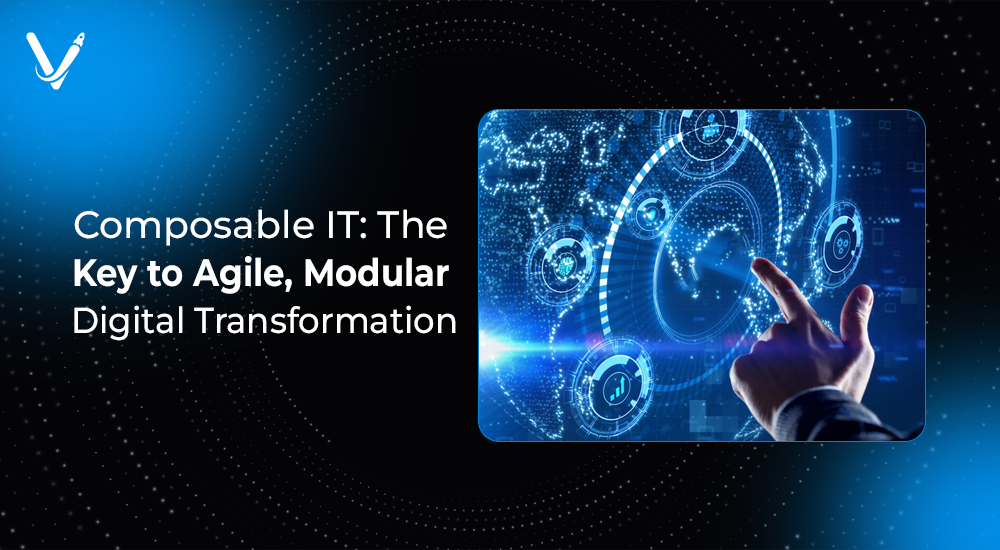In today’s hyper-digital landscape, businesses thrive by adapting swiftly, integrating efficiently, and scaling intelligently. Traditional IT infrastructures, once robust, now often fall short of supporting the dynamic needs of modern enterprises. Enter Composable IT, a strategy that enables organizations to rapidly assemble, reassemble, and adapt digital capabilities through modularity.
This article explores how Composable IT is revolutionizing digital transformation services, empowering businesses to unlock new levels of agile methodology, cost efficiency, and operational flexibility. We’ll delve into composable architecture, real-world use cases, and actionable implementation strategies that pave the way for next-gen IT services.
Understanding Composable IT: Building Blocks of a New Digital Era
Composable IT is an architectural approach where IT resources are abstracted and delivered as services. These services can be dynamically composed to meet specific business needs.
Key Characteristics
- Modular IT Components: Infrastructure, applications, and data are packaged as discrete components.
- Dynamic Assembly: Elements can be assembled and reassembled as required.
- Cloud-Native Architecture: Built on microservices, APIs, containers, and orchestration tools.
Why It Matters
- Supports agile methodology and DevOps practices
- Enhances cloud agility and flexibility
- Enables cost efficiency through better resource allocation
What Is Composable Software?
Composable software refers to applications that are built using discrete, interchangeable components. These can be microservices, APIs, or packaged business capabilities (PBCs).
Core Elements
- Microservices: Lightweight, independently deployable services.
- API Standardization: Ensures smooth integration across systems.
- Automation: Facilitates self-healing, deployment, and scalability.
This approach leads to business agility, as IT teams can respond faster to changes in the market or customer expectations.
The Shift Toward Composable Architecture
Organizations are increasingly moving away from monolithic systems. Composable architecture provides a flexible, scalable alternative.
Benefits of Composable Architecture
- Modular IT Infrastructure: Reduced dependency on legacy systems.
- Cloud Agility: Seamless integration with multi-cloud and hybrid cloud setups.
- Security: Enhanced through service isolation and centralized control.
- Cost Efficiency: Lower TCO by reusing services across business units.
Real-World Example
Adobe Experience Platform allows marketers to personalize experiences using composable data and services. It exemplifies how composability enhances user engagement.
Composable IT in Action: Use Cases Across Industries
Healthcare
- Data Center Optimization through modular EHR systems
- Automation of patient data workflows with APIs
- Integration of wearable data via cloud-native architecture
Retail & E-commerce
- Adoption of composable commerce platforms like commercetools
- Real-time personalization and inventory updates
- Cost efficiency by reusing services across geographies
Banking & Finance
- API-driven integration of fraud detection services
- Hybrid cloud support for regulatory compliance
- Accelerated development with DevOps and microservices
Benefits of Composable IT for Digital Transformation Services
Composable IT plays a crucial role in delivering digital transformation services that are:
- Adaptive: Respond quickly to changes
- Resilient: Recover and scale efficiently
- Efficient: Optimize resource usage and costs
- Secure: Minimize surface attack areas with isolated services
Strategic Advantages
- Accelerates DevOps workflows
- Bridges the talent gap by abstracting complexity
- Enables faster go-to-market with new services
DevOps and Agile Methodology in Composable IT
Composable IT aligns naturally with DevOps and agile methodology, encouraging continuous integration, delivery, and feedback loops.
DevOps Enhancements
- Automation of infrastructure provisioning
- Seamless collaboration across development and operations
- Real-time observability for faster debugging
Agile Synergy
- Shorter iteration cycles through modular development
- Rapid prototyping with reusable APIs
- Cross-functional team alignment with shared microservices
API Standardization and the API Economy
API standardization is the backbone of composability. It enables systems to communicate efficiently and securely.
The Rise of the API Economy
- Monetizing APIs as digital products
- Driving partnerships and B2B integrations
- Creating unified customer experiences
Case Study: Stripe
Stripe’s standardized API model has made it a go-to platform for payments, enabling rapid integration and global scalability.
Navigating Security in a Composable World
Security remains a priority. Composable IT strengthens it through modular, zero-trust principles.
Composable Security Best Practices
- Zero Trust Architecture: Authenticate every user and request
- Centralized Policy Management: Govern all modules from a single source
- Automation of security patches and updates
By reducing the attack surface and enforcing granular controls, composability enhances both operational security and compliance.
Addressing the Talent Gap with Composable IT
The talent gap in IT can be narrowed by embracing composable strategies.
How It Helps
- Simplifies development via low-code and no-code modules
- Enables non-developers to assemble services
- Reduces onboarding time with modular, well-documented components
Cloud-Native and Hybrid Cloud Synergies
Composable IT thrives in cloud-native architecture and hybrid cloud environments.
Advantages
- Run workloads across public, private, and edge locations
- Optimize performance and compliance requirements
- Enable data center optimization and cost control
Example
Spotify operates across hybrid clouds using microservices to ensure seamless music delivery regardless of user location or device.
Unlocking Business Agility Through Composability
Business agility is a critical success factor. Composable IT enables:
- Quick adaptation to customer demands
- Easy experimentation with minimal risk
- Alignment between business and IT
This fosters an environment where innovation is encouraged and rapidly executed.
Implementing Composable IT: A Step-by-Step Guide
Define Objectives
- Align IT modularity with business goals
- Identify key metrics for success
Assess Infrastructure Readiness
- Evaluate existing legacy systems
- Determine cloud readiness and migration paths
Embrace Automation and DevOps
- Deploy CI/CD pipelines
- Automate provisioning, scaling, and rollback
Standardize APIs
- Adopt common data formats and protocols
- Build governance around integration layers
Start Small and Scale
- Begin with pilot projects
- Iterate and improve based on real-time feedback
Challenges and How to Overcome Them
Resistance to Change
- Educate stakeholders on benefits
- Demonstrate quick wins with prototypes
Integration Complexity
- Use API gateways and service meshes
- Leverage open-source frameworks
Cost Concerns
- Measure ROI based on modular reuse and agility
- Reduce vendor lock-in with open standards
The Future of Digital Transformation Services
With the rise of AI, edge computing, and 5G, the future of digital transformation services will be increasingly composable, scalable, and intelligent.
Emerging Trends
- AI-powered orchestration of services
- Smart APIs that adapt to usage patterns
- Composable platforms in IT services, retail, healthcare, and beyond
Conclusion: The Road Ahead
Composable IT is not just an IT trend—it’s a strategic enabler of digital transformation services. By adopting modular IT principles and leveraging composable architecture, organizations can accelerate innovation, reduce costs, and enhance agility across every facet of operations.
Now is the time to rethink your IT strategy.
Let Vasundhara Infotech help you embrace Composable IT and unlock the full potential of agile methodology, cloud-native architecture, and composable commerce.
Contact us today to modernize your IT infrastructure for a smarter, faster future.




